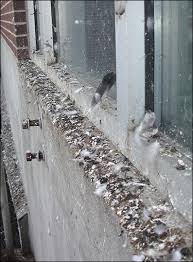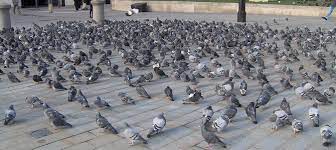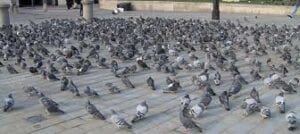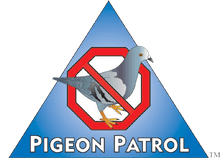
by Pigeon Patrol | Aug 9, 2021 | Pigeon Droppings, Pigeon Patrol's Services, Pigeon Predators, Pigeon Spikes, Pigeons, Pigeons in the News
We learn that there are five senses (sight, hearing, touch, smell and taste). And we say that there is the “sixth sense,” meaning intuition or a hunch. But there is a physiological seventh sense that detects magnetic fields and, in some species, an eighth sense that detects electrical fields, and perhaps other senses still to be discovered.
Many animals (and plants!) have magnetoreception: birds, turtles, mice, bats, ants, lobsters, bees, newts, fishes, to list a few examples. The capability is also present in bacteria and may be a basic sense in virtually all organisms. However, it is one thing to demonstrate experimentally that an organism is able to sense and respond to magnetic fields, but it is quite another thing to learn how, or if, the magnetic sense is used by the organism.
A real-life function of magnetic sense is known in many animals. For instance, homing pigeons use magnetic sense to locate their home roost. Migratory birds use magnetoreception as well as celestial cues to find the way between nesting and wintering grounds. Sea turtles use this sense to find their nesting beaches and their hatchlings use it, along with light, to find their way to the sea. Some salamanders and toads use magnetic sense to orient themselves to the shore of a pond or to locate their home pond. Certain ants and bees use magnetic (and other clues) to navigate between their nests and food sources. Salmon use magnetic clues, with odor clues, to navigate back to their ‘home’ streams to spawn. An electrical sense of sharks interacts with magnetic sense, allowing them to orient themselves in the ocean.
The plot thickens, however, as researchers discovered magnetic reception and responses at all stages of fish development. For instance, magnetic fields affect the movement of sperm and their success in fertilizing eggs, as well as the size of the resulting embryos and their orientation. The behavior, orientation, heart rates and hormonal activities of larvae and fry are affected by magnetic fields too. The biological significance of these responses apparently remains to be determined.
And what about magnetic sense in plants, which don’t move around? Experiments have shown effects of magnetic fields on such features as flowering time, seed germination and seedling growth, photosynthesis, the behavior of pollen and roots, and enzyme activity. But the importance of these responses in the real world is anything but clear.
How does magnetoreception work? Only the briefest, most simplistic explanation can fit in the space of this essay. The earth’s main magnetic field has three features that can provide information to suitable receptors. The field varies in intensity, which varies with location and the horizontal or vertical orientation of the force. Another feature is called “inclination,” referring to the distance from the surface to the depths of the earth; inclination is very steep near the poles and flatter near the equator, so it gives an index of distance from the poles (i.e., latitude). The field also can provide a compass direction; the declination of a compass indicates deviation from the North Pole/South Pole axis of rotation of the earth (related, roughly, to longitude, and depending on latitude). In addition to the main field, there are local anomalies, commonly caused by magnetized rock.
How do animals sense those magnetic features? Some animals have tiny particles of magnetic material in their beaks, snouts, brains or elsewhere. Another way involves a protein called cryptochrome, found in both animals (including humans) and plants, which undergoes a complex reaction allowing detection of magnetic inclination. In bird eyes, cryptochrome is activated by blue light and may create a filter for light falling on the retina, making a pattern that changes when a bird moves its head, changing the angle between head and magnetic field. There are other possibilities too. In any case, any information gleaned from magnetic features has to be related to an internal map or some other point of reference, if it is to be used for orientation and navigation.
Note that the magnetic sense is so sensitive that it can work over very small distances, such as when a bird moves its head. It has also been invoked as a possible explanation for how foxes orient that marvelous jump as they pounce with their front feet on a rodent under the snow.
Source
Pigeon Patrol Products & Services is the leading manufacturer and distributor of bird deterrent (control) products in Canada. Pigeon Patrol products have solved pest bird problems in industrial, commercial, and residential settings since 2000, by using safe and humane bird deterrents with only bird and animal friendly solutions. At Pigeon Patrol, we manufacture and offer a variety of bird deterrents, ranging from Ultra-flex Bird Spikes with UV protection, Bird Netting, 4-S Bird Gel and the best Ultrasonic and audible sound devices on the market today.
Voted Best Canadian wholesaler for Bird Deterrent products ten years in a row.
Contact us at 1- 877– 4– NO-BIRD, (604) 585-9279 or visit our website at www.pigeonpatrol.ca
Pigeon/Pigeon Patrol / Pigeons Roosting / Vancouver Pigeon Control /Bird Spikes / Bird Control / Bird Deterrent / Pigeon Deterrent? Surrey Pigeon Control / Pest /Seagull deterrent / Vancouver Pigeon Blog / Birds Inside Home / Pigeons in the cities / Ice Pigeons/ What to do about pigeons/ sparrows , Damage by Sparrows, How To Keep Raccoons Away, Why Are Raccoons Considered Pests/ De-fence / Pigeon Nesting/ Bird Droppings / Pigeon Dropping/ woodpecker control/ Professional Bird Control Company/ Keep The Birds Away/ Birds/rats/ seagull/pigeon/woodpecker/ dove/sparrow/pidgeon control/pidgeon problem/ pidgeon control/flying rats/ pigeon Problems/ bird netting/bird gel/bird spray/bird nails/ bird guard

by Pigeon Patrol | Aug 9, 2021 | Pigeon Patrol's Services, Pigeon Predators, Pigeon Spikes, Pigeons, Pigeons in the News, Raccoons
It may sound hard to believe, but pigeons are actually a bit of a nuisance to human populations, no matter how attractive these pests can be. Pest control measures frequently include pigeon deterrent procedures due to the risk of disease and property damage that pigeons can bring.
When getting rid of pigeons, practical traps and repellents are the best options to utilise to ensure the birds are repelled from your property. Falconry, anti-bird spikes, parallel wires, bird netting, bird gels, decoy kites, and lasers are all effective in ridding pigeons from your property.
This article will go over some basic tips about pigeon behaviour as well as a range of ways to help keep pigeons away. Read on to discover more. If you are interested in our pigeon control services then please contact us for a quote.
Pigeon Behaviour
Pigeons have long been a bird that is renowned for its beauty but feared for its nuisance behaviour. The types of pigeons that regularly cause concern for home and business owners are known as feral pigeons.
Pigeons will typically gather together in a behaviour known as roosting, which is easily seen by detecting large groups of pigeons congregating on rooftops and the eaves and sides of buildings. Even if you go to great lengths to never feed pigeons to help get rid of them, most people usually feed pigeons inadvertently by dropping grain-rich foods on the ground and leaving the lids of waste bins.
Similar in the way that cockroaches and bed bugs are dependent on humans for food and shelter, it can be said that pigeons share the same trait. These pests have come to rely on grains for survival, which is why pigeons are a staple of the surrounding environment of agricultural sites, feed processing plants, as well as parks, large recreation areas, and restaurants located within cities.
This may not sound alarming, but pigeons regularly drop waste on sidewalks and buildings, which can damage the exterior look of structures over time. Additionally, people can slip and fall when walking through pigeon waste, and feral pigeons can actually carry a range of diseases.
With this in mind, considering how to get rid of pigeons is a valid question to ask.
How to Get Rid of Pigeons Without Hurting Them
It is illegal to kill pigeons or any other wild bird species due to the wording of the Wildlife and Countryside Act of 1981. This means that the birds can only be repelled, and by far, the best way to scare pigeons and keep nesting pigeons away is to use falconry.

Falconry
There are some products that you can use to deter pigeons (more on these below), but the use of birds of prey is great because this natural method directly triggers the fight or flight response within pigeons.
Our method is to allow our birds to circle and fly over the problem area on a regular basis. Pigeons soon get the message that the territory is occupied by a predator, and will take wing and move on.
Using a natural threat like this is the most humane and effective way to rid your property of pigeons on a long-term basis. Falconry can deter pigeons and prevent pigeons from becoming a nuisance to your property, and you do not have to worry about utilising spike strips or other pigeon deterrents to get rid of pigeons.
Additional Procedures to Take to Keep Pigeons Away
When it comes to figuring out how to get rid of pigeons, falconry is the most natural and effective form of pest control you can use. Precautionary measures like removing bird feeders or leaving food and water out of bird feeders can be effective, but it will likely take more than refraining from the urge to feed pigeons to break up the habit of roosting.
In all of the following procedures, you have to make sure that whatever form of pest control you take, the pigeons may become accustomed to the devices, and therefore, you may have to change up the procedure from time to time to get rid of pigeons and keep them away.
Let’s explore some methods to get rid of pigeons:
Anti-Bird Spikes
Anti-bird spikes or ‘spike strips’ are a set of attachable spikes that can be fastened to a surface to prevent pigeons from perching or nesting in areas you want to keep bird-free. The spikes will not necessarily harm the birds, which is good in order to stay on the right side of the law; however, the spikes will deter the birds from setting up shop wherever the spikes are laid.
Parallel Wires
Bird-proofing with parallel wires is a great way to keep pigeons away from your roof or other areas of your home that are attractive to the birds. This method works by using parallel wires that run across the structure that prevents pigeons from landing and nesting.
Bird Netting
Bird netting is somewhat unsightly but is very effective at keeping pigeons out of certain places. This mesh netting works much like the previous examples and creates a net barrier that prevents the birds from nesting.
Bird Gels
A sticky trap, or sticky gel, is a bird repellent that keeps pigeons at bay by using a chemical that creates a translucent barrier across structures that causes a bird’s feet to become stuck to the surface, which makes the bird struggle to get free. A pigeon would not want to go through the experience of having to break free of the sticky chemical a second time and therefore, will avoid landing on structures that contain the gel.
Decoy Kites
Decoy kites can get rid of bird populations by using a kite-shaped decoy bird image to sway in the wind to deter a pigeon from landing in a certain area. This method can be effective, but it may not work since decoys can sometimes be easily overlooked, which makes this method problematic to get rid of pigeons.
Lasers
Lasers used against pigeon populations can be effective due to the piercing light that blinds the pigeons once they scout an area for nesting or roosting. This method can be initially effective, however, the pigeons may become accustomed to the lasers over time and simply get out the way.
What Do Pigeons Hate?
Pigeons hate the sight or presence of other domineering birds, such as birds of prey. This is what makes falconry such a successful deterrent in getting rid of pigeon populations.
Additionally, pigeons do not like strong smells, such as cinnamon or hot pepper juice or spray. If you can safely reach the areas where the pigeon colony is roosting and nesting, you can spray and apply these substances to help drive the birds away.
How Do I Get Rid of Pigeons On My Roof?
Pigeon colonies look for places to hide and nest and there is no better area better suited for this than the roof. When it comes to figuring out how to scare off pigeons from your roof, the best method is to figure out methods that will keep populations away from the roof.
A good pigeon repellent to consider using for your roof is bird netting or parallel wires. These two methods need little upkeep on your part and can work around the clock to keep the birds firmly off of your roof.
If you are wondering how to scare pigeon colonies from roof structures, decoy kites require less installation, but you have to make sure the birds do not become used to the sight of the decoy kite.
Falconry is the easiest method to consider since our birds mimic the same basic patterns of flight and acclimating to heights as pigeons.
What Smell Do Pigeons Not Like?
As previously mentioned, strong and repellent scents and smells like pepper or even essential oils may deter pigeon populations for a time. To get rid of pigeons completely with smells, you would have to consistently spread the scents all over their roosting and nesting spots to make the habitat unlivable.
Source
Pigeon Patrol Products & Services is the leading manufacturer and distributor of bird deterrent (control) products in Canada. Pigeon Patrol products have solved pest bird problems in industrial, commercial, and residential settings since 2000, by using safe and humane bird deterrents with only bird and animal friendly solutions. At Pigeon Patrol, we manufacture and offer a variety of bird deterrents, ranging from Ultra-flex Bird Spikes with UV protection, Bird Netting, 4-S Bird Gel and the best Ultrasonic and audible sound devices on the market today.
Voted Best Canadian wholesaler for Bird Deterrent products ten years in a row.
Contact us at 1- 877– 4– NO-BIRD, (604) 585-9279 or visit our website at www.pigeonpatrol.ca
Pigeon/Pigeon Patrol / Pigeons Roosting / Vancouver Pigeon Control /Bird Spikes / Bird Control / Bird Deterrent / Pigeon Deterrent? Surrey Pigeon Control / Pest /Seagull deterrent / Vancouver Pigeon Blog / Birds Inside Home / Pigeons in the cities / Ice Pigeons/ What to do about pigeons/ sparrows , Damage by Sparrows, How To Keep Raccoons Away, Why Are Raccoons Considered Pests/ De-fence / Pigeon Nesting/ Bird Droppings / Pigeon Dropping/ woodpecker control/ Professional Bird Control Company/ Keep The Birds Away/ Birds/rats/ seagull/pigeon/woodpecker/ dove/sparrow/pidgeon control/pidgeon problem/ pidgeon control/flying rats/ pigeon Problems/ bird netting/bird gel/bird spray/bird nails/ bird guard

by Pigeon Patrol | Aug 9, 2021 | Doves, history of pigeons, MBCA, pet bird, Pigeon Control, Pigeon Droppings
For thousands of years, humans have bred rock doves (a.k.a. pigeons) to travel home over massive distances. These domesticated pigeons have helped us fight wars, find shipwrecks, and deliver blood samples. But despite our long partnership, we have yet to understand exactly how they navigate hundreds of miles back to their roost. New research shows that they may, in part, be sniffing their way home.

To navigate, scientists believe that birds use both a map and a compass. The compass—the sun or the Earth’s magnetic field—tells pigeons where, say, south is. The map, which tells them home is south, could come from odors carried on winds around a pigeon’s home perch, reports German ornithologist Hans Wallraff, of the Max Planck Institute for Ornithology, in the journal Biogeosciences.
Earlier research revealed that impairing a pigeon’s sense of smell disorients the bird so that they cannot return to their home site. Wallraff’s meticulous study of air samples surrounding a pigeons’ roost suggests that odors offer consistent location cues. He believes that this can allow birds to learn to associate a given direction with a scent. So when they’re traveling and detect a certain odor—whether the sharp scent of seawater, ripe reek of the local dump, or mouth-watering aroma of a bakery—they build a mental map of the area using their olfactory memories.
In fact, the scent trail may be so strong that pigeons can navigate by it alone, Wallraff’s new model shows. Wallraff input data from his previous air sampling work, which included 46 odorous chemical compounds from 96 sites surrounding the pigeons’ home. He then modeled whether virtual birds could learn to navigate using these odoriferous signals. He found that over evolutionary time, birds become more sensitive to scents and can in fact use these pungent clues to travel home.
Although he has yet to determine which odorous chemical clues are most important, Wallraff’s findings reveal how avian olfaction may enable a bird to successfully traverse more than 1,000 miles, which is nothing to sniff at.
Source
Pigeon Patrol Products & Services is the leading manufacturer and distributor of bird deterrent (control) products in Canada. Pigeon Patrol products have solved pest bird problems in industrial, commercial, and residential settings since 2000, by using safe and humane bird deterrents with only bird and animal friendly solutions. At Pigeon Patrol, we manufacture and offer a variety of bird deterrents, ranging from Ultra-flex Bird Spikes with UV protection, Bird Netting, 4-S Bird Gel and the best Ultrasonic and audible sound devices on the market today.
Voted Best Canadian wholesaler for Bird Deterrent products ten years in a row.
Contact us at 1- 877– 4– NO-BIRD, (604) 585-9279 or visit our website at www.pigeonpatrol.ca
Pigeon/Pigeon Patrol / Pigeons Roosting / Vancouver Pigeon Control /Bird Spikes / Bird Control / Bird Deterrent / Pigeon Deterrent? Surrey Pigeon Control / Pest /Seagull deterrent / Vancouver Pigeon Blog / Birds Inside Home / Pigeons in the cities / Ice Pigeons/ What to do about pigeons/ sparrows , Damage by Sparrows, How To Keep Raccoons Away, Why Are Raccoons Considered Pests/ De-fence / Pigeon Nesting/ Bird Droppings / Pigeon Dropping/ woodpecker control/ Professional Bird Control Company/ Keep The Birds Away/ Birds/rats/ seagull/pigeon/woodpecker/ dove/sparrow/pidgeon control/pidgeon problem/ pidgeon control/flying rats/ pigeon Problems/ bird netting/bird gel/bird spray/bird nails/ bird guard

by Pigeon Patrol | Aug 9, 2021 | Pigeon Spikes, Pigeons, Pigeons in the News, Raccoons, Sparrows, UltraSonic Bird Control
Scientists have discovered the secret of pigeons’ remarkable ability to navigate perfectly over journeys of several hundred miles. They do it by smell.
Research found that pigeons create ‘odour’ maps of their neighbourhoods and use these to orient themselves. This replaces the idea that they exploited subtle variations in the Earth’s magnetic field to navigate.
‘This is important because it is the first time that magnetic sensing and smell have been tested side by side,’ said Anna Gagliardo, of the University of Pisa, who led the research.
The discovery that birds have an olfactory positioning system is the latest surprising discovery about bird migration. Birds know exactly when to binge on berries or insects to fatten themselves for long flights, and some species recognise constellations, which helps them to fly at night. Birds also travel immense distances: the average Manx shearwater travels five million miles during its life.
Research into navigation has included an experiment in which robins were released with a patch over one eye – some on the right eye, some on the left. The left-eye-patched robins navigated well, but those with right-eye patches got hopelessly lost. ‘It is a very strange finding,’ said Graham Appleton, of the British Trust for Ornithology . ‘It is clear the cues robins use to navigate are only detectable in one eye. Why that should be the case, I have no idea.’
In the Pisa experiments, Gagliardo, working with Martin Wild of the University of Auckland , followed up experiments done in 2004, which showed that pigeons could detect magnetic fields. She argued that this did not mean they actually did.
So in 24 young homing pigeons she cut the nerves that carried olfactory signals to their brains. In another 24 pigeons she cut the trigeminal nerve, which is linked to the part of the brain involved in detecting magnetic fields.
The 48 birds were released 30 miles from their loft. All but one of those deprived of their ability to detect magnetic fields were home within 24 hours, indicating that it was not an ability that helped them to navigate. But those who had been deprived of their sense of smell fluttered all over the skies of northern Italy. Only four made it home.
Gagliardo and her team conclude that pigeons read the landscape as a patchwork of odours.
Every spring, hundreds of millions of birds head north in order to exploit new resources. Gulls head to the Arctic to make use of the 24 hours of daylight prevailing there, while swallows and other birds leave Africa to exploit the British summertime.
The navigation involved in these long journeys is still a cause of considerable debate among scientists. Among the main theories are suggestions that some birds remember visual maps of the terrain they fly over; that they follow the lines of Earth’s magnetic field; and that night-time flyers remember star maps of the sky.
However, the discovery of pigeons’ prowess at exploiting smells is considered important because their navigational abilities are some of the most acute in the natural world. Pigeons excel at getting home when released in unfamiliar locations. That they achieve such accuracy using smell is all the more surprising.
Source
Pigeon Patrol Products & Services is the leading manufacturer and distributor of bird deterrent (control) products in Canada. Pigeon Patrol products have solved pest bird problems in industrial, commercial, and residential settings since 2000, by using safe and humane bird deterrents with only bird and animal friendly solutions. At Pigeon Patrol, we manufacture and offer a variety of bird deterrents, ranging from Ultra-flex Bird Spikes with UV protection, Bird Netting, 4-S Bird Gel and the best Ultrasonic and audible sound devices on the market today.
Voted Best Canadian wholesaler for Bird Deterrent products ten years in a row.
Contact us at 1- 877– 4– NO-BIRD, (604) 585-9279 or visit our website at www.pigeonpatrol.ca
Pigeon/Pigeon Patrol / Pigeons Roosting / Vancouver Pigeon Control /Bird Spikes / Bird Control / Bird Deterrent / Pigeon Deterrent? Surrey Pigeon Control / Pest /Seagull deterrent / Vancouver Pigeon Blog / Birds Inside Home / Pigeons in the cities / Ice Pigeons/ What to do about pigeons/ sparrows , Damage by Sparrows, How To Keep Raccoons Away, Why Are Raccoons Considered Pests/ De-fence / Pigeon Nesting/ Bird Droppings / Pigeon Dropping/ woodpecker control/ Professional Bird Control Company/ Keep The Birds Away/ Birds/rats/ seagull/pigeon/woodpecker/ dove/sparrow/pidgeon control/pidgeon problem/ pidgeon control/flying rats/ pigeon Problems/ bird netting/bird gel/bird spray/bird nails/ bird guard

by Pigeon Patrol | Aug 9, 2021 | Bird Spikes, Columbidae, Doves, history of pigeons, MBCA, pet bird, Pigeon Control
DEAR JOAN: Yesterday afternoon I blew the leaves off the lawn and garden in my backyard, leaving a lot of bare soil showing. A couple of hours later, I happened to look outside and to my wondering eyes there appeared a dozen beautiful little robins, pecking away all over the yard.
I must have unearthed grubs or something edible, but how did they know that? They stayed an hour, then took off together. What a delight.
Earlier in the week I awoke at 3 a.m. to the smell of a skunk in my front yard. I live in a neighborhood of small houses, all with the fenced yards. I never cease to wonder how these wild creatures manage to get around and find food.

Dorothy Rich
Bay Area
DEAR DOROTHY: Birds have such supercharged metabolisms that when they are active, they pretty much have to eat constantly to maintain their energy. As a result, birds are exceptionally good at finding food.
They do this not by scent — with very few exceptions, birds have a rotten sense of smell — but by sight and sound.
As they fly and flit around, they are scoping out the landscape. They may spot a bird feeder, a bush full of berries, or a cleared patch of dirt. They may not recognize it as such, but they see the changes in the landscape and drop down to explore.
Birds have amazing little brains and memories, so the robins probably noticed something had changed in your yard, and that all that dirt was holding a feast.
Birds also listen to the calls and coos of other birds, which can tip them off about a source of food.
American robins eat a variety of foods, but they certainly love nice juicy worms, and they are most adept at finding them.
Folks used to believe the robins could hear the worms crawling about beneath the soil, but researchers have found that it’s just experience. They know where worms likely are, and they hunt them out, not unlike me and frozen yogurt shops.
As for the skunks and other critters, they too are driven by the need for food and water, and they are undeterred by urban fences.
Mating season for skunks usually begins in February, but I’m already seeing a lot of skunks out and about, and unfortunately, dead on the roads, so I think they might be getting an early start this year. Just a reminder that the males use their scent to attract females, so we will be smelling that pungent aroma a lot in the coming weeks.
Hero Dog awards
The American Humane Association, a national organization that works to improve the lives of both animals and children, has launched its annual Hero Dog awards to recognize the country’s bravest heroes on both ends of the leash.
The awards are divided into eight categories — therapy, service, law enforcement, military, arson, search and rescue, guide/hearing and “emerging hero” dogs, which pays tribute to ordinary dogs that do extraordinary things.
Winners in each category will be treated to a Los Angeles gala awards ceremony in September, where one of the finalists will be named top dog.
Source
Pigeon Patrol Products & Services is the leading manufacturer and distributor of bird deterrent (control) products in Canada. Pigeon Patrol products have solved pest bird problems in industrial, commercial, and residential settings since 2000, by using safe and humane bird deterrents with only bird and animal friendly solutions. At Pigeon Patrol, we manufacture and offer a variety of bird deterrents, ranging from Ultra-flex Bird Spikes with UV protection, Bird Netting, 4-S Bird Gel and the best Ultrasonic and audible sound devices on the market today.
Voted Best Canadian wholesaler for Bird Deterrent products ten years in a row.
Contact us at 1- 877– 4– NO-BIRD, (604) 585-9279 or visit our website at www.pigeonpatrol.ca
Pigeon/Pigeon Patrol / Pigeons Roosting / Vancouver Pigeon Control /Bird Spikes / Bird Control / Bird Deterrent / Pigeon Deterrent? Surrey Pigeon Control / Pest /Seagull deterrent / Vancouver Pigeon Blog / Birds Inside Home / Pigeons in the cities / Ice Pigeons/ What to do about pigeons/ sparrows , Damage by Sparrows, How To Keep Raccoons Away, Why Are Raccoons Considered Pests/ De-fence / Pigeon Nesting/ Bird Droppings / Pigeon Dropping/ woodpecker control/ Professional Bird Control Company/ Keep The Birds Away/ Birds/rats/ seagull/pigeon/woodpecker/ dove/sparrow/pidgeon control/pidgeon problem/ pidgeon control/flying rats/ pigeon Problems/ bird netting/bird gel/bird spray/bird nails/ bird guard








